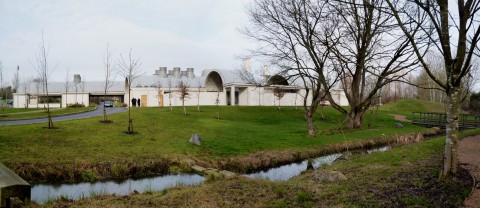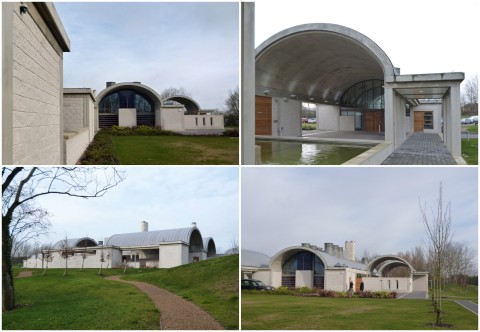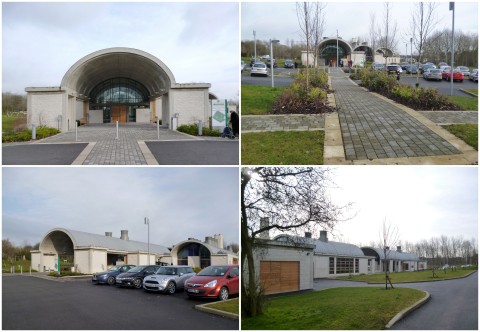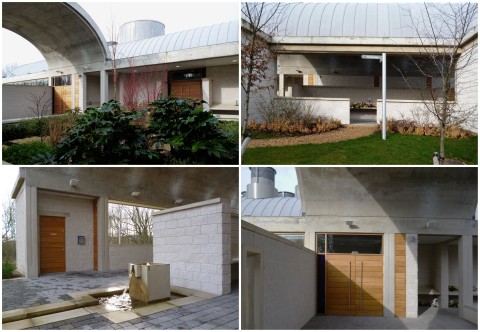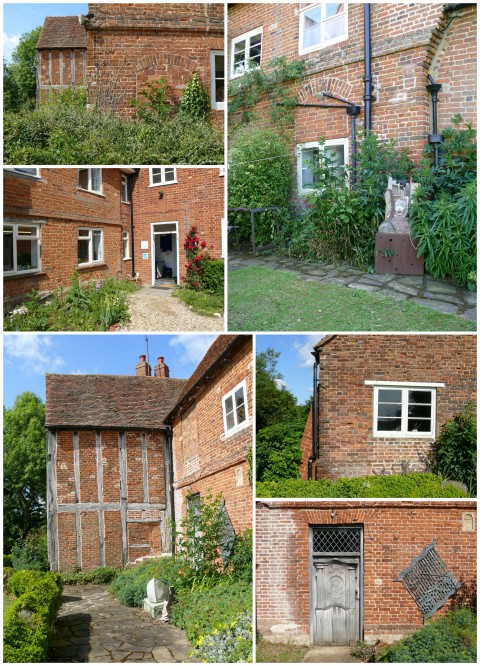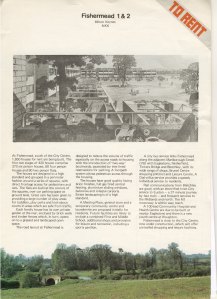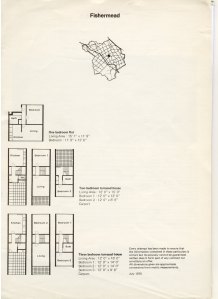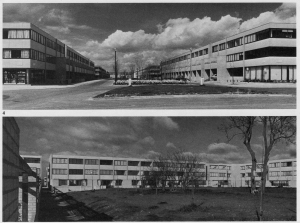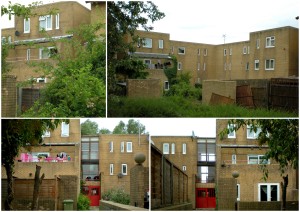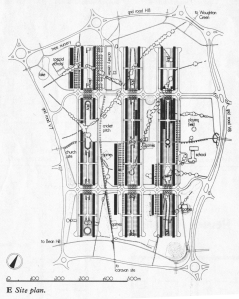Crematorium, Crownhill, Milton Keynes. An homage to Louis Kahn.
February 11, 2013
The high quality of architectural and planning output during inception, birth and infancy of Milton Keynes was not accidental. Derek Walker led a gifted team of professionals working with him in MK Development Corporation and commissioned good architects of international and national repute to build housing, civic and other building types within the city.
The demise of MKDC in 1992 and subsequent political changes started to dismantle the architectural department within the Council which was supposed to take over and supervise the responsibility of completing the growth of the city.
The financial constraints and changes in house building/selling sector started a race to build to obtain biggest profits and financial savings without much regard for sensible commissioning in order to obtain the best possible architectural quality to fulfil the original goals of design and planning.
The decline in architectural standards is so overwhelming that the earlier levels of ‘acceptable/mediocre’ can now easily pass as ‘excellent’ and if anything of some merit is built, it is welcomed with disbelief and needs celebrating.
The building of Crownhill Crematorium is such an example where a series of happy coincidences led to ‘birth’ of a building dealing with the emotional issues of ‘death’.
The so called birth took place in the back seat of a taxi (assisted by the father) as it was rushing to reach hospital.
Adrian Morrow, the young project designer with an impressive list of buildings to show against his name and a long list of first class architectural practices he has worked for, happened to be working in Architects Department during its death throes when this project arrived on his desk. The rapid population growth of the city meant that the existing crematorium built in 1982 by Roger Hobbs was unable to cope with the increased demands.
Adrian Morrow’s commitment to good architecture must have speeded his efforts to complete work on Crematorium detailed design, fighting against uncertainty of existence as Council’s architect. The new energy regulations and sustainability issues were dealt with and working drawing stage completed speedily before the inevitable ‘Project Managers’ took over the job and Council’s Architecture Department’s ‘life support’ was withdrawn and unwittingly the department became the first candidate for cremation in the new building (metaphorically speaking of course, just like Asplund’s in Woodland Cemetery).
The opportunity of seeing a worthwhile building in Milton Keynes after a while is too good to miss. It may not be able to withstand a direct comparison with Asplund-Lewerentz’s Woodland Cemetery in its scale, masterly handling of landscape and classicism of Swedish vernacular but there were lessons to be learnt.
The comparison with the other famous example of Funerary buildings, Scarpa’s Brion Family Cemetery (1968-78) would be grossly unfair at various levels but relevant when considering the experience of family and friends during emotionally traumatic occasions when the intimate internal and external spaces are able to offer solace and contemplation to affected users.
However, since the architect fairly and openly acknowledges Louis Kahn’s Kimbell Art Museum as the main inspiration for this building, a few related things are worth discussing.
Like most architects of his age, Adrian Morrow knows and understands Kahn’s work, (as Charles Correa’s use of Kahn’s Trenton Bath House at Gandhi Ashram in India) chose to use Kimbell’s vocabulary of concrete vaults with flat roofs to create ‘servant and served’ spaces. A good model to follow, as judicial spacing of vaulted roofs proved flexible to cope with varying and sensitive space requirements of the brief for internal and external spaces.
The roof was originally designed before the sustainability requirements imposed rows of wind catchers. These clusters distract the eye from the simplicity of extruded vaults used by Kahn, but since the intentions are noble and a touch of ‘science fiction’ adds an extra layer of experience, I find it more than acceptable.
My main disappointment lies with the way the car park sits in front of the building dominating the approach and exit for the mourners. The act of approaching the imposing entrance vault through cars looks abrupt and cluttered. Similarly the car park dominates the view as you leave the chapel using the side exit via an intimate well designed landscaped courtyard, created by parting of two vaulted roofs. The marrying of cars building and landscaped/water side walk is unresolved and to a degree lets the project down.
The experience of washing your hands using the warm water in the toilets attached to the entrance vault on a cold morning was even more satisfying knowing that the source of heat for this water was provided by recent departed ‘user clients’. You can’t but say “Thank you and Thank you God for effective recycling….”
Adrian Morrows web site with a video:
http://www.ajmarchitecture.com/envprojectajm.html
An excellent video showing Scarpa’s Brion Family Cemetry;
http://architechnophilia.blogspot.co.uk/2011/12/carlo-scarpa-brion-tomb.html
Westbury, Artists Studios in an old farm, Milton Keynes
June 22, 2011
Westbury Farm is one of the hidden treasures of Milton Keynes. This ancient rambling farm has provided a shelter for many artists for more than 30 years and has also become a resting place for either insitu ‘installations’, unfinished, unsuccessful or experimental works which could not reach the desired standards or intended destination by the artists occupying the farm.
The following abstract comes from a case study for Westbury Farm carried out by The Price’s Regeneration Trust.
“Westbury Farm is a 17th century timber framed farmhouse with brick infill and is Grade II listed. Milton Keynes Development Corporation (MKDC) compulsory purchased the farm and farmhouse for development purposes with the intention to develop the site out as part of the masterplan for the new town of Milton Keynes. The farmhouse and land surrounding it today remain undeveloped in the south-west of Milton Keynes and are now in the ownership of the successor of MKDC, the Homes and Communities Agency (HCA).
MKDC were approached by the Silbury Group, an artist led not for profit organisation, to lease the farmhouse for use as artist studios. MKDC at the time were keen to promote art in Milton Keynes so to encourage artists to move to the new town, and the provision of artist studios at Westbury Farm was seen as an important step in achieving this aspiration.
Lasting outcomes
HCA has continued the arrangement which sees the farmhouse occupied rather than left vacant and vulnerable, resulting in reduced security and general holding costs while ensuring that the farmhouse remains in good condition.
Leasing the farmhouse to the Silbury Group has meant that any problems in regards to repairs and general maintenance requirements are reported to the HCA as and when they arise, preventing repair and maintenance issues escalating in terms of cost and scale as a result of such issues not being identified quickly enough. All of these benefits deliver value for money in the interests of the tax payer, as well as resulting in a sustainable temporary use for the farmhouse that benefits the local community.
A disposal strategy for the farmhouse will be identified when the land surrounding the farmhouse comes forward for development. As the farmhouse has been well maintained then it is unlikely that there will be any conservation deficit, making the asset more attractive to potential purchasers.”
The activity shown in the lawn infront of the farm is a weekend Raku Workshop which took place earlier this month.
Some of the ‘left-over’ works are constant reminders of artists who lived and worked here in the past and their works are only recognizable by their distinct styles.
Quiz: Below is the out come of most of the Raku day. Can you hazard a guess as to which part of the table houses the handiwork of a ‘cranky’ architect?
Cofferidge Close, Stony Stratford. Under threat?
July 31, 2010
In February I jotted down the short history of this project which started its life as a brilliant contribution to the new built environment in this historical town, now an integral part of the new city of Milton Keynes. I pointed out in some detail many ‘retrogressive’ recent changes which seriously undermined the original strength and qualities. You are still able to see the frail patient walking about, an occasional smile still reveals some of the original attractive charm the patient possessed.
However, recently my attention was drawn to an exhibition in Stony Stratford and this web site http://www.cofferidgeclose.co.uk/ displaying proposals for developing and improving this site and seeking public participation and involvement before submitting formal planning applications.
This apparent democratic and inclusive method has now become an almost text book approach for testing the waters and finding the best and cheapest route for most of the developers to do what they are there for; build big, cheap, and make an quick exit with a neat profit.
The proposal is so ill conceived and poor that in all seriousness you can not even appraise it apart from saying that far from preserving and enhancing the character of the area (a pre-requisite for any proposal within a Conservation Area), this scheme would destroy it in all major aspects.
One sentence can adequately summarise this proposal. An attempt to insert a grossly oversized building in a beautifully crafted space in the heart of a sensitively redeveloped area. The huge mass of building is moored in a sea of enlarged car parking and service areas, proposing to destroy the trees in the orchard which provides pleasant walking routes through this park like well landscaped site. The directness of short cuts linking the little ally ways would be destroyed and and the walk through the car park can hardly be compensated by planting few trees in left over spaces.
The best way to describe this broad daylight attempt of this ‘grab and run venture’ is the following analogy;
- Imagine a pretty little ornate cage in a nicely decorated front room of an old thatched cottage with a lovely little singing bird. The bird lost a few feathers after a confrontation with a house cat when it escaped the cage through an open door, but survived and continued with well rehearsed melodies and preening the colourful plumage in this handsome spacious cage.
- Suddenly the old owner of this bird was taken ill and had to go to a Nursing Home and the bird was sent to another house with a large bird cage which it was able to share happily with other similar birds.
- After a while a new owner, another bird lover, came to live in this cottage. The owner loved the lovely little bird cage in the front room, but unfortunately had a large barn owl to look after. The owl was far too large for the cage and indeed the door. It managed to get in but found it difficult to move within it. The children from the neighbourhood who knew the singing, colourful bird came and apart from the initial thrill of seeing a big bird with funny head and round eyes, they missed the colourful singing bird and wanted it back.
- The kind new owner did not want to disappoint the children and said, ” I tell you what! Tell me your three favourite colours and I would be happy to colour owl’s feathers in your favourite colour. If you like I will even mix two or three of the colours to make it even more cheerful. I also have a CD of the loveliest bird songs you can think of, and I will play it when you visit me.”
- Fortunately the children were far too intelligent to go along with this ploy. The owner also saw that the owl would never fit in the cage and thankfully gave it away to someone with proper owl accommodation. He also bought another small pretty singing bird and all was well in the old cottage.
I hope the local residents would strongly object to this outlandish proposal and ensure that this idea is killed before it is even considered as a worthwhile project for any planning permission.
Unless we learn to appreciate and protect all the best of old and recently built environments around us, opportunistic profiteers would do their best to sell us things under the guises of doing us favours. Hopefully we are now mature enough to recognize the merits of what we have and know who the real beneficiaries of these false promises are likely to be.
